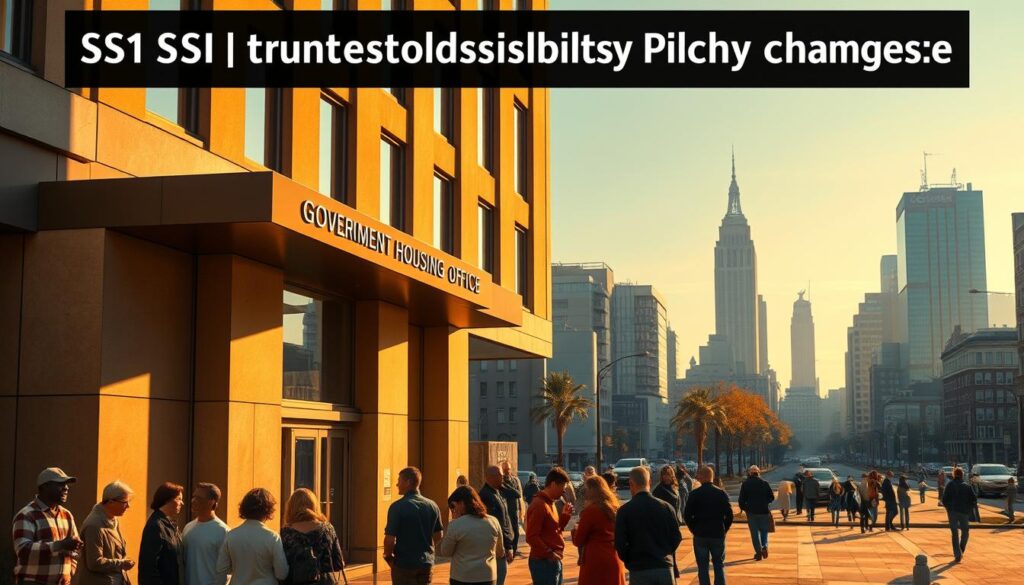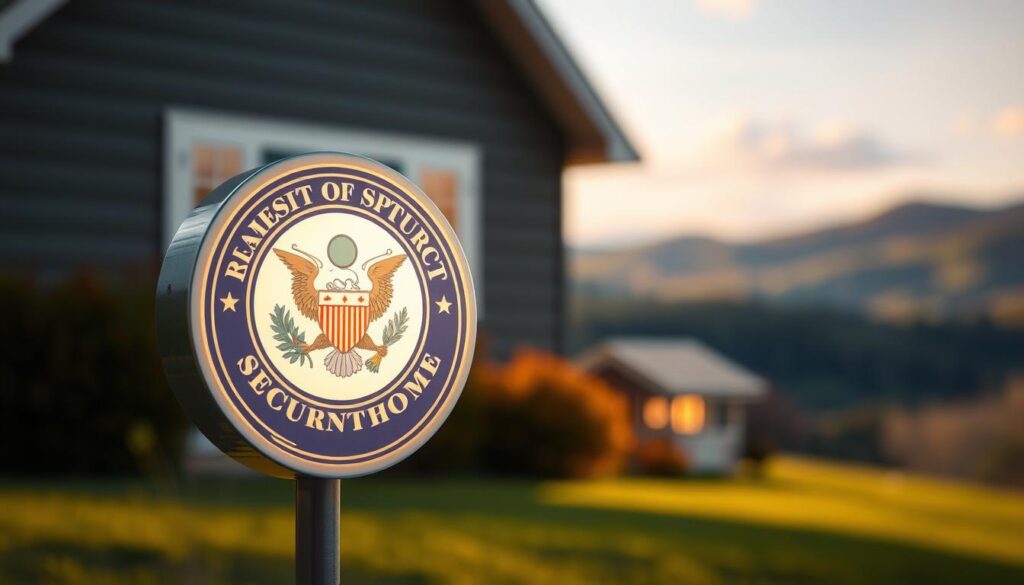Dealing with money troubles can be tough, especially if you have disabilities or a fixed income. The Social Security Administration gets this and has made a big change. They’re updating the Supplemental Security Income (SSI) rental help program to help thousands of Americans.
The Social Security Administration has made a big move for SSI applicants and recipients across the country. Starting September 30, 2024, the rental help policy will grow. It will help more people find affordable housing.
This change is a big step towards fairer access to social security benefits. It makes getting rental help easier and could raise monthly payments for those who qualify.
Table of Contents
Understanding the New SSI Rental Subsidy Policy Change
The Social Security Administration is making a big change in its housing subsidy program. This change will help more people get the help they need. It’s a big step forward for those who are struggling.

This new policy will change how SSI recipients get rental help. Starting September 30, 2024, more people will get help with their rent. This is a big deal for those who need it most.
Overview of Social Security Administration’s Final Rule
Here are the main points of the new policy:
- Nationwide expansion of rental subsidy guidelines
- Increased financial support for disability benefits recipients
- Simplified application process for housing subsidy
Implementation Timeline and Key Dates
The Social Security Administration has a plan for when things will happen:
- September 30, 2024: Official policy implementation date
- October 1, 2024: Full nationwide rollout begins
- January 2025: Complete integration of new rental subsidy rules
National Policy Extension Beyond Seven States
The policy used to only cover seven states. Now, it will cover all 50 states. This change will help about 41,000 individuals get more money each month.
| Policy Aspect | Current Status | New Policy |
|---|---|---|
| Geographic Coverage | 7 States | All 50 States |
| Expected Benefit Increase | Limited | Average $132/month |
| New Eligible Recipients | Restricted | Approximately 14,000 annually |
This change shows the Social Security Administration’s dedication to helping more people. It’s a big step towards making sure everyone has access to the help they need.
What is Supplemental Security Income (SSI)?

Supplemental Security Income (SSI) is a key federal program. It gives financial help to those in need in the United States. It supports adults and children with disabilities, the blind, and seniors aged 65 and older who have little income and resources.
By January 2023, over 7 million individuals got SSI benefits. They received an average of $654 each month. This program is a vital safety net for those facing basic needs like housing, food, and healthcare.
Key aspects of the SSI program include:
- Providing monthly financial support to eligible individuals
- Covering essential living expenses
- Offering support for those with limited economic resources
SSI benefits are given to different groups:
| Recipient Category | Number of Recipients |
|---|---|
| Aged Recipients | 1.1 million |
| Blind Recipients | 62,000 |
| Disabled Recipients | 6.3 million |
The Social Security Administration runs this program. It makes sure those who need it most get financial help. In 2023, the U.S. spent $60.8 billion on SSI. This shows how important it is for low-income Americans.
“SSI provides a critical lifeline for millions of Americans who would otherwise struggle to meet their basic needs.” – SS Administration
Current SSI Rental Assistance Program Structure
It’s important to know how the Social Security Administration helps with housing. The SSI rental subsidy policy has rules for who gets help and how much. These rules are based on complex calculations.

When checking if someone is eligible for housing help, the program looks at a few things:
- Income limits and household size
- Current Market Rental Value (CMRV)
- Presumed Maximum Value (PMV) calculations
- Unearned income
Eligibility Requirements and Income Limits
To get housing support, you must meet certain income rules. The Social Security Administration checks:
- Total household income
- How much you own
- If you live in the country legally
- If you’re old or disabled
Current Market Rental Value (CMRV) Calculations
The CMRV sets the standard rent for areas. It helps the SSA figure out if you need housing support. They compare your rent to what others pay in your area.
| Rental Subsidy Factor | Calculation Method |
|---|---|
| Market Rate Determination | Local area median rental prices |
| Subsidy Adjustment | Difference between actual and market rent |
| Income Impact | Proportional reduction in benefits |
Presumed Maximum Value (PMV) Explained
The PMV is the most housing support SSI recipients can get. It takes into account where you live and any extra income from lower rent.
PMV helps standardize rental assistance across different living situations and geographic regions.
Social Security to Expand SSI Rental Subsidy Policy: Changes Ahead

The Social Security Administration is making big changes to the supplemental security income rental assistance policy. Starting September 30, 2024, a new rule will change how rental subsidies are given to SSI recipients across the country.
Key changes in the SSI rental subsidy policy include:
- Extended coverage from seven states to all states
- Potential payment increases for approximately 41,000 individuals
- Expected average monthly benefit increase of $132
- Simplified qualification process for rental assistance
The changes aim to make it easier for individuals getting SS benefits. For many SSI recipients, this means a more accurate calculation of rental expenses. They might also get higher monthly payments.
With the new rule, the Presumed Maximum Value (PMV) for rental subsidy will be $334.33 in 2024. This change could greatly affect how SSI benefits are figured out. It’s especially important for those living with family or in shared housing.
The goal is to provide more comprehensive support for older adults and individuals with disabilities in low-income households.
About 7.5 million Americans get supplemental security income every month. These policy changes could help more people get the financial support they need.
Impact on Current SSI Recipients
The Social Security Administration has made big changes for Supplemental Security Income (SSI) recipients. These updates will help those with disability benefits a lot.
The new policy will bring a lot of financial relief. Here are some key points:
- About 41,000 SSI recipients will get a monthly increase of $132 on average.
- Another 14,000 people will start getting SSI benefits every year.
- The highest SSI payment will be $943 in 2024.
Potential Benefit Increases
The rental subsidy policy changes will make a big difference. Starting on September 30, SSI recipients can look forward to more stable and possibly higher payments.
“These changes represent a significant step toward supporting low-income individuals and those with disabilities” – Social Security Administration Representative
Changes in Payment Calculations
The new policy changes how SSI benefits are figured out. Here are some important updates:
- Food will no longer be counted in In-Kind Support and Maintenance.
- Reporting requirements will be simpler.
- Payments will be less likely to change from month to month.
By 2033, about 277,000 federal SSI recipients might see their monthly payments go up. This is about 4% of all beneficiaries. The goal is to offer better support to those who need it most.
Benefits for New SSI Applicants
The new Supplemental Security Income (SSI) rental subsidy policy is a big change for new applicants. Starting January 2023, over 7 million people get SSI benefits, with an average of $654 a month. The new policy aims to open more doors for government aid to those who need it.
New SSI applicants will see several important benefits:
- Expanded eligibility criteria
- Potential for increased monthly benefit amounts
- Reduced reporting burden
- More flexible income calculations
The Social Security Administration’s new rules, starting September 30, 2024, will change how rental subsidies are figured out. Now, the Presumed Maximum Value (PMV) of $334.33 will let for more flexible business deals without cutting SSI checks.
| Benefit Aspect | New Policy Impact |
|---|---|
| Rental Subsidy Calculation | More lenient assessment of income sources |
| Eligibility Expansion | Increased opportunities for qualification |
| Benefit Reduction Risk | Reduced potential for benefit cuts |
Knowing about these changes can help you understand SSI benefits better. Not everyone will get more money, but the new policy offers more chances for those with little income and resources to get the help they need.
State-by-State Implementation Details
The Social Security Administration is making a big change in housing support. They are expanding the SSI rental subsidy policy across the country. This change is important for helping vulnerable populations find homes.
Before, seven states had special rules for this policy. These states were Texas, Connecticut, New York, Vermont, Illinois, Indiana, and Wisconsin. They were the first to try out this new way of helping with housing.
Nationwide Expansion Strategy
The Social Security Administration has a plan for this big change. Here are the main parts:
- They will use the In-Kind Support and Maintenance (ISM) rental subsidy exception everywhere
- They will make sure everyone gets the same amount of help with rent
- They want to make it easier for SSI recipients to get this help
Implementation Timeline
There are important dates for this change:
- December 31, 2024: They will start using electronic payroll data
- January 6, 2025: They will start making changes in field offices
- May 11, 2025: They will give more time for healthcare checks
By making this change, the SS Administration wants to help more people. They want to make sure low-income individuals, especially seniors and people with disabilities, have a place to live.
How the New Rental Subsidy Calculations Work
Learning about the new SS rental assistance calculations is key. It helps you understand the changes in Supplemental Security Income (SSI) benefits. The SS Administration has a new way to figure out rental subsidies. This could change how much money you get each month.
The main part of these new rules is the Presumed Maximum Value (PMV). For 2024, the limit on rental subsidy is $334.33. This means the SS Administration will use this as a standard when checking rental help for SSI recipients.
- The PMV of $334.33 is the highest rental subsidy amount
- An unearned income exclusion of $20 per month will be applied
- Calculations will look at your living situation
Your benefit amount will depend on many things. This includes where you live, your income, and who lives with you. The new policy wants to give more accurate and fair rental help to SSI recipients.
About 41,000 people might get around $132 more each month because of these changes. The SS Administration made these updates to make the SSI program easier. They also hope to help more people get benefits.
Understanding these calculations can help you know your potential benefits and financial support better.
Additional Social Security Administrative Changes
The SS Administration (SSA) is making big changes to help more people. These updates will make it easier to get government aid. Millions of Americans will benefit from these changes.
In fall 2024, the SSA will change how it counts food help. Food from friends, family, and community groups won’t lower your SSI benefits anymore. This could mean a $131 monthly increase for about 90,000 people.
The SSA is also improving digital services. Soon, over 30 forms will accept electronic signatures. This is a big step towards making things easier for everyone. The agency has already helped five million people with secure online access.
These changes show the SSA’s dedication to making things simpler. They’re working to help more people with financial needs. This includes better rental help and easier application processes.
FAQ
What is the Social Security Administration’s new SSI rental subsidy policy?
When will the new SSI rental subsidy policy take effect?
Who is eligible for SSI benefits?
How will the rental subsidy policy expansion affect my current SSI benefits?
What is the Presumed Maximum Value (PMV) in SSI calculations?
Will new SSI applicants see different benefits under this policy?
How does this policy change impact rental assistance for SSI recipients?
Are there any additional administrative changes coming with this policy?
How can I determine if I’ll be affected by these changes?
What should I do to prepare for these policy changes?
There are no reviews yet. Be the first one to write one.

